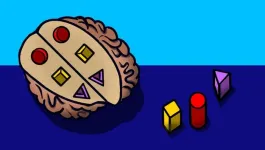(Press-News.org) (San Diego, Calif.---September 7, 2024, 8:30 a.m. PCT) — A study presented today at the International Association for the Study of Lung Cancer 2024 World Conference on Lung Cancer demonstrated a promising pathway toward developing predictive biomarkers for immune checkpoint inhibitors.
In non-small cell lung cancer, immune checkpoint inhibitors offer significant promise, yet their efficacy is limited to a subset of patients. Identifying reliable predictive biomarkers is crucial for optimizing treatment responses.
Research led by Dr Arutha Kulasinghe’s team from The University of Queensland and Prof Ken O’Byrne at the Princess Alexandra Hospital in collaboration with Dr Ettai Markovits from Nucleai and the team at Akoya Biosciences, revealed that the intricate profiles of the tumor microenvironment are key to predicting which patients are likely to benefit from these therapies.
Kulasinghe and their colleagues analyzed a retrospective cohort of NSCLC tissue samples from 45 patients treated with immune checkpoint inhibitors. Their group used advanced multiplexed immunofluorescence (mIF) staining combined with deep learning-based analysis, and classified cells into 15 distinct types and further categorized them using unsupervised clustering techniques.
“By mapping over 1000 spatial features within tumor and TME regions, we compared characteristics between responders and non-responders to identify predictive patterns,” O’Byrne reported.
Their team identified 43 unique cell subsets, which were primarily differentiated by their metabolic and activation states. Key proteins linked to oxidative phosphorylation and metabolic pathways, such as CS, SDHA, ATPA5, HK1, GLUT1, and LDHA, were differentially expressed.
A notable finding was the association between metabolically active lymphocytes—characterized by elevated PD-1, MHC class I and II, and CD44 levels—and their presence in tumor infiltrating lymphocytes and tertiary lymphoid structures. Tumor cells were classified into three metabolic states: OXPHOS+, OXPHOS-, and PPP+, with PPP+ cells showing increased proliferation, CD44 positivity, and a higher resistance to PD-1 blockade. Tumors with over 40% PPP+ cells were associated with poorer response to PD-1 inhibitors and reduced overall survival.
“This research reveals complex relationships between metabolic states, immune cell functionality, and responses to immunotherapy, and offers a promising pathway toward developing predictive biomarkers for ICIs,” Kulasinghe said.
The findings highlight the potential for enhancing patient selection and treatment outcomes through detailed metabolic profiling of the tumor microenvironment, he reported.
About the IASLC:
The International Association for the Study of Lung Cancer (IASLC) is the only global organization dedicated solely to the study of lung cancer and other thoracic malignancies. Founded in 1974, the association's membership includes more than 10,000 lung cancer specialists across all disciplines in over 100 countries, forming a global network working together to conquer lung and thoracic cancers worldwide. The association also publishes the Journal of Thoracic Oncology, the primary educational and informational publication for topics relevant to the prevention, detection, diagnosis, and treatment of all thoracic malignancies. Visit www.iaslc.org for more information.
About the WCLC:
The World Conference on Lung Cancer (WCLC) is the world’s largest meeting dedicated to lung cancer and other thoracic malignancies, attracting nearly 7,000 researchers, physicians and specialists from more than 100 countries. The goal is to increase awareness, collaboration and understanding of lung cancer, and to help participants implement the latest developments across the globe. The conference will cover a wide range of disciplines and unveil several research studies and clinical trial results. For more information, visit https://wclc2024.iaslc.org.
END
Research shows pathway to developing predictive biomarkers for immune checkpoint inhibitors
2024-09-07
ELSE PRESS RELEASES FROM THIS DATE:
Just how dangerous is Great Salt Lake dust? New research looks for clues
2024-09-07
As Utah’s Great Salt Lake shrinks, exposing more of its playa, concerns grow about the dust the dry lakebed emits. But scientists lack the data to fully understand what pollutants are present in these airborne sediments.
Researchers from the University of Utah are attempting to get a handle on this question and the latest findings are concerning.
Sediments in the lake’s exposed playa are potentially more harmful than other major dust sources affecting the Wasatch Front’s air quality, according to a study published online recently in the journal Atmospheric Environment.
These sediments, when ...
Maroulas appointed Associate Vice Chancellor, Director of AI Tennessee
2024-09-06
The University of Tennessee, Knoxville, has appointed Vasileios Maroulas associate vice chancellor and director of the AI Tennessee Initiative. AI Tennessee was established in 2022 to strengthen UT’s research in AI, expand the number of UT students developing AI skills and competencies, and position the state of Tennessee as a national and global leader in the data-intensive knowledge economy.
“I look forward to advancing UT into a leader for AI research, innovation, and education,” said Maroulas. “By harnessing the power of transdisciplinary research, pioneering new learning ...
New chickadee research finds cognitive skills impact lifespan
2024-09-06
New chickadee research finds cognitive skills impact lifespan
Working ‘smarter’ not harder important to natural selection and survival rates
While there is no denying ‘survival of the fittest’ still reigns supreme in the animal kingdom, a new study shows being smartest – or at least smarter – is pretty important, too.
Western University animal behaviour and cognition researcher Carrie Branch and her collaborators at the University of Nevada, Reno and the University of Oklahoma tracked the spatial cognition and ...
Cognitive behavioral therapy enhances brain circuits to relieve depression
2024-09-06
Cognitive behavioral therapy, one of the most common treatments for depression, can teach skills for coping with everyday troubles, reinforce healthy behaviors and counter negative thoughts. But can altering thoughts and behaviors lead to lasting changes in the brain?
New research led by Stanford Medicine has found that it can — if a therapy is matched with the right patients. In a study of adults with both depression and obesity — a difficult-to-treat combination — cognitive behavioral therapy that focused on problem ...
Terasaki Institute awarded $2.3 Million grant from NIH for organ transplantation research using organs-on-a-chip technology
2024-09-06
September 6, 2024 —Researchers at the Terasaki Institute for Biomedical Innovation have been awarded a multi-million grant from the National Institutes of Health (NIH) to advance research in organ transplantation and antibody-mediated rejection. This funding will facilitate the development of an innovative multi-organs-on-a-chip platform aimed at transforming our understanding of transplant rejection and immune tolerance.
Organ transplantation is widely recognized as the most effective treatment for organ failure. However, the need for lifelong immunosuppressive ...
Atoms on the edge
2024-09-06
Typically, electrons are free agents that can move through most metals in any direction. When they encounter an obstacle, the charged particles experience friction and scatter randomly like colliding billiard balls.
But in certain exotic materials, electrons can appear to flow with single-minded purpose. In these materials, electrons may become locked to the material’s edge and flow in one direction, like ants marching single-file along a blanket’s boundary. In this rare “edge state,” electrons can flow without ...
Postdoc takes multipronged approach to muon detection
2024-09-06
NEWPORT NEWS, VA – When Debaditya Biswas was a high school student in India, his math teacher, Dr. Satyabrata Das, sparked his interest in physics.
“Before I joined his class, I was really not sure what I was going to do in life,” said Biswas, a postdoctoral research associate at Virginia Tech. “He revealed the beauty of science to me.”
Now, as the 2024 Jefferson Science Associates (JSA) Postdoctoral Prize winner, Biswas hopes to reveal a new method for the U.S. Department of Energy's Thomas Jefferson National Accelerator Facility to detect muons.
By themselves, muons aren’t actually that difficult for physicists to detect. They are a type ...
Mathematical proof: Five satellites needed for precise navigation
2024-09-06
As a rule, GPS indicates our location with an accuracy of just a few meters. But we have all experienced situations where the possible error increases to a few hundred meters or the indicated location is simply wrong. One reason for this can be the small number of satellites with line-of-sight contact to the navigation device or unfavorable relative alignment of the satellites.
How does GPS work?
GPS satellites are equipped with an extremely accurate atomic clock and know their positions at all times. They continually transmit the time and their location using radio waves. A mobile phone ...
Scalable, multi-functional device lays groundwork for advanced quantum applications
2024-09-06
Researchers have demonstrated a new multi-functional device that could help advance the scalability of solid-state color centers, enabling them to be used in larger and more complex quantum computers and networks. As efficient photon-spin interfaces, solid-state color centers are promising candidates for qubit nodes — essential units for storing and processing quantum information.
Solid-state color centers are point defects that can absorb and emit light at specific wavelengths. To be useful in real-world quantum applications, they must be optically addressable in a fast and controllable manner while also allowing ...
Falling for financial scams? It may signal early Alzheimer’s disease
2024-09-06
Older adults who are more vulnerable to financial scams may have brain changes linked to a higher risk of Alzheimer’s disease, according to a first-of-its-kind study led by researchers at the USC Dornsife College of Letters, Arts and Sciences.
Nearly 7 million Americans are living with Alzheimer’s disease, the fifth leading cause of death among those 65 and older. The disease will carry an estimated $360 billion in health care costs this year alone, according to the Alzheimer’s Association.
Researchers led by Duke Han, professor ...






